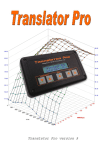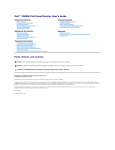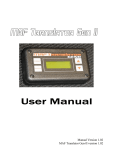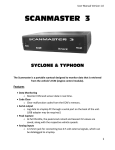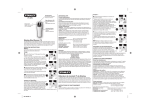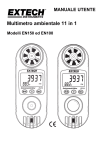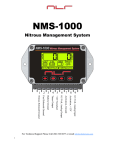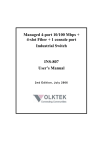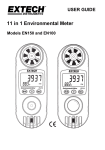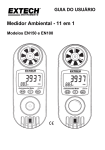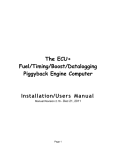Download User Manual - Full Throttle Speed Tech Support
Transcript
User Manual Manual Version 1.0 Translator Pro version 4.4x Table of Contents Kit Contents:......................................................................................... - 3 Available Accessories and Options:..................................................... - 3 Introduction: ........................................................................................ - 3 Main Airflow Modes ............................................................................ - 4 Installation Details ............................................................................... - 6 Speed Density Installation. .................................................................. - 6 Translator Mode Installation............................................................... - 7 AFC Mode Installation. ....................................................................... - 7 Using the Keypad ................................................................................. - 7 Translator Pro Pages: .......................................................................... - 8 Speed Density Mode Setup................................................................... - 8 Speed Density Standard Connections................................................ - 10 Translator Mode Setup ...................................................................... - 10 Translator Mode Standard Connections ........................................... - 12 AFC Mode Setup and Standard Connections ................................... - 13 Parameter setting details for all pages: ............................................. - 14 Tuning with the Translator Pro......................................................... - 18 Open Loop vs. Closed Loop................................................................ - 19 Boost Control...................................................................................... - 20 AFR Tracking .................................................................................... - 21 TunerPro RT for tuning and logging (overview):............................. - 23 Speed Density Algorithm.................................................................... - 26 Glossary:............................................................................................. - 27 Translator Pro Harness Connector Details....................................... - 28 - Translator Pro User Manual --2-- Kit Contents: The Translator Pro kit is shipped with the following items. Translator Pro unit Standard splice harness, 10 pin Standard splice harness, 6 pin Serial cable for programming, tuning, and logging CD ROM containing documentation, and software Splice and tap connectors Manual Available Accessories and Options: Boost control solenoid Boost control harness (Plug-and-play and splice-in) MAP (Manifold Absolute Pressure) sensor IAT Sensor (Intake Air Temperature) sensor Speed Density harness (Plug-and-play and vehicle specific) Accessory power pack (offline power supply, 120VAC) Introduction: The Translator Pro is a powerful electronic module that allows the user to tune the engine performance of a modern fuel-injected vehicle. The unit is configurable for many different types of vehicles. Using its various operational modes, the user can adjust fuel delivery, turbo boost, and other operating parameters to extract more performance from their vehicles' engine. Warning: The Translator Pro is a powerful tool for adjusting the operation of the engine. It is possible to mis-adjust the settings and cause damage to the engine. The user must read and understand this entire User Guide before attempting to install and use the Translator Pro. Adjustments should be made in small increments with continuous testing to ensure the engine is operating within its mechanical limits. The primary function of the Translator Pro is to allow the user to adjust the air-fuel ratio of their engine. This is accomplished by adjusting the Translator Pro User Manual --3-- amount of airflow the Engine Computer Module (ECM) or Engine Control Unit (ECU) perceives is entering the engine. If the ECM/ECU senses less airflow is entering the engine, it will command less fuel be injected into the engine, thus making the Air/Fuel ratio "leaner". If the airflow signal is reduced by 1%, the resultant fuel delivery will be less by 1%. For example, an engine is consuming 100 grams of air per second, and the ECU is delivering fuel for 12:1 Air/Fuel Ratio (AFR). If the airflow signal to the ECU is reduced to 95 grams per second (5%), the ECU will delivery fuel for this amount of air. The resulting AFR will be 12.6:1 (5% leaner). Main Airflow Modes The Translator Pro sends airflow information in the form of an electrical signal (voltage or pulse frequency) to the ECU. Frequency signals are send on the green, "frequency out" wire of the 10 pin harness. Voltage signals are sent on the Brown (V Out 1) or the Gray (V out 2) wires of the 10 pin Main harness. Speed Density Mode (MAF Eliminator) The Translator Pro serves to replace the airflow sensing hardware on the vehicle. The unit uses a sophisticated Speed Density algorithm to calculate engine airflow based on external sensors. This airflow calculation is used to synthesize a signal to send to the ECM/ECU, and the vehicle's original airflow sensor can be removed. MAF Translator Mode The unit can be used to adapt a different airflow sensor to a vehicle. A large, high performance MAF (Mass Airflow) sensor can be installed on a vehicle not originally equipped with one, in order to increase performance. The unit can be used to install a high flow MAF on cars originally equipped with small, restrictive Karman Vortex or mechanical/flap airflow meters. Examples include using a GM LS1 or LS6 MAF on a Toyota Supra, Mitsubishi Eclipse, or Ford SVO Mustang. Airflow Computer Mode (AFC) The unit can be used to adjust the signals from the vehicles originally installed airflow sensor in order to tune the vehicles performance. Translator Pro User Manual --4-- Translator Pro User Manual --5-- Pressure Aux or O2/WB input Frequency In Intake Air Temperature Manifold TPS RPM Density Calculations Airflow Source User Tune High Load / RPM Mid Load / RPM Low Load / RPM Air Temp Corrections Aux Mode / RPM RPM TPS Frequency In High Load / RPM Mid Load / RPM Low Load / RPM Air Temp Corrections Aux Mode / RPM User Tune Gain Limits Target AFR / RPM AFR Tracking Volt Out Freq Out AFC Mode. Set F Out Mode to 0 Select Speed Density or Translator mode MAF Input (Analog or Frequency) Volumetric Efficiency Response Tuning Afterstart Correction Engine displacement Engine # of cylinders Speed Gain Limits Target AFR / RPM AFR Tracking Volt Out Freq Out Installation Details This section contains installation details that are not specific to any particular vehicle. Please refer to the appendix and other installation diagrams contained on the CD included in the Translator Pro kit. Harness connections are referred to by connector designation M, S, E, (Main, Sensor, and Expansion) and pin number, for example the +12V main power input is connected to the pink wire at M5, Ground at M10. In this manual, TAP means to connect to a harness wire without cutting it. Splice means to cut a harness wire and connect Translator Pro wires to the cut ends. Wire Splicing and Tapping information The Translator Pro is installed by connecting wires into the vehicle's wiring harness. Good connections are absolutely necessary for proper, reliable operation. A loose or intermittent connection could cause improper fuel delivery at full throttle resulting in engine damage. Squeeze style tap connectors are included in the kit due to their popularity, but are not the most reliable means of connection. To use the squeeze style properly they must be installed firmly. Regular slipjoint pliers are best for this. If there is doubt about the users ability to install the squeeze taps properly, or the wiring area is subject to vibration, soldering the connections is recommended. The pink spade connectors included in the kit are of the best quality and will provide good reliability when properly crimped. Inexpensive crimpers may not crimp firmly enough. Tug on the crimped connection to ensure there is no looseness and the wire does not pull out. When in doubt, solder the connections. For additional details on soldering the connections, refer to this guide: http://www.mmxpress.com/technical/connections.htm Speed Density Installation. Using a speed density harness, install and connect a MAP sensor and IAT sensor. The MAP sensor needs to be installed using a piece of vacuum hose connected to the intake manifold plenum. The sensor must read vacuum in order to properly control fueling at idle and part throttle. If the vacuum source is too close to an individual cylinder, the vacuum will fluctuate excessively, resulting in poor drivability. The IAT should be installed so that its sensing element can read the temperature of the air entering the engine. On turbocharged vehicles Translator Pro User Manual --6-- this is usually the pipe that leads from the intercooler to the throttle body. The sensor can be installed in the intake manifold, but the possibility of "heat soak" is increased. Remove the MAF sensor from the vehicle and install an air filter on the inlet duct. If a vehicle specific harness is being used, refer to those instructions for wiring details. Otherwise use a universal Speed Density harness or wire the sensors directly to the splice harness included with the Translator Pro kit. Install the Translator Pro wiring, splicing in to the MAF signal wire so the Translator Pro can alter its signal. If the original MAF had extra signals, wire the analog outputs to those ECU wires so the Pro can generate those signals. Tap the TPS and RPM signals. Translator Mode Installation. Remove the vehicle's original MAF and install the upgraded MAF. If a plug-and-play harness is available, follow the instructions specific for it. Otherwise wire the new MAF such that the signals use the original vehicle wiring. Install the Translator Pro wiring, splicing in to the MAF signal wire so the Translator Pro can alter its signal. If the original MAF had extra signals, wire the analog outputs to those ECU wires so the Pro can generate those signals. Tap the TPS and RPM signals. AFC Mode Installation. Install the Translator Pro wiring, splicing in to the MAF signal wire so the Translator Pro can alter its signal. Tap the TPS and RPM signals. Using the Keypad The Translator Pro is equipped with a 5-key keypad and LCD to allow the user to make tuning adjustments to the unit without needing a laptop computer or other external device. Most tunable parameters are accessible from the keypad. There are 3 main sets of data that are manipulated with the keypad: page, range, and setting. The page is selected by holding the PG (page) key, then pressing either RangeUp or RangeDn to select the desired page. The page description is displayed while PG is depressed. On any page, the RangeUp and RangeDn select the range to be adjusted, SetUp and SetDn change the setting of that range. For example, to adjust the airflow (and consequentially the air/fuel ratio) at idle, select the AF Lo page by holding PG and using RangeUp or RangeDn to select the Airflow Low page. Then use the Translator Pro User Manual --7-- RangeUp or RangeDn key to select the RPM range that s closest to idle speed. Then use the SetUp or SetDn keys to adjust the setting. The Config and Setup pages are used to configure the unit for a specific kind of car and airflow mode. These pages require an extra step to gain access in order to prevent inadvertent changes. To enable access to the Config and Setup pages, hold the PG button depressed for 10 seconds until the display shows "Config Enabled". Then these pages can be used to configure the Translator Pro. Translator Pro Pages: Use these pages to set the operating modes for your specific vehicle configuration Config Select: Set the unit for the vehicle and sensors connected System Setup: Settings related to the selected configurations Boost Control: Settings using the boost control output on the EXP connector AFR Tracking Air Temp: User AF tune vs. IAT, this adjustment is in addition to the normal compensation Aux Trig: User AF tune that is activated when the AUX input is activated AF Hi: High load AF tune vs. RPM. AF Mid: Mid load AF tune vs. RPM AF Low: Low load AF tune vs. RPM Response: Adjustments for response to changes in MAP and TPS (tipin) (Speed Density only) Sensor Monitor: Display operating and tuning parameters. Spark WOT: Adjust WOT (Wide Open Throttle) spark advance (not all vehicles) Spark Aux: Adjust WOT (Wide Open Throttle) spark advance when AUX mode is activated (not all vehicles) Speed Density Mode Setup The Translator Pro is a high-tech engine tuning device that fills the technology gap between the popular but simple piggyback tuning devices and the full-blown, expensive standalone engine management systems. The Translator Pro uses sophisticated computations to determine engine airflow, thus relieving the user of the daunting task of completely mapping the engine s operation. Once the initial setup is Translator Pro User Manual --8-- complete, there is usually little tuning required to attain smooth operation and drivability. The Engine Control Module (ECM) or Engine Control Unit (ECU) in a vehicle is a small computer unit responsible for calculating how much fuel is injected into the engine. The fuel is injected to match the air flowing into the engine. The Translator Pro, like traditional piggyback controllers allows the user to adjust the airflow measurement, thus changing how much fuel the ECM/ECU injects into the engine. This is how the user tunes the engine. The Translator Pro is unique in that it allows the user to remove air measurement devices (MAS, MAF, VAF, etc) from the engine and use a speed density calculated signal to replace it. In high performance engine applications this has many advantages and added flexibility. To enable Speed Density mode enter the engine and sensor parameters in the Config and Setup pages. The Translator Pro uses the engine parameters to calculate the airflow. Then set Airfl Srce (Airflow Source) to 0 or 1 so the Translator Pro will calculate airflow via the speed density algorithm. Use 0 if the ECU is not getting temperature information via another signal. Use 1 if the ECU is receiving air temp information and will compensate its fuel delivery. Some vehicles have MAF sensors with other functions or signals. These other signals are typically Barometric pressure and Air Temperature. These MAF sensors are actually "Air Volume" sensors, and the ECU uses the temperature and pressure data to calculate the airflow mass. When using a calculated airflow mass (speed density) the air temp and baro signals must be kept constant to prevent double-compensation. These other signals can be simulated by the Translator Pro, using the V Out 1 and V Out 2 signals. Set the V out 1 and 2 mode to 0 in the Config page, and set the output voltages to normal levels in the Setup page. If the vehicle ECU requires a voltage MAF signal (Ford, some Toyota, etc) connect Analog Output 1 to the ECU MAF input and configure V Out 1 mode for the correct analog MAF signal calibration. Translator Pro User Manual --9-- Translator Pro User Manual Ground Sensor Signal 5 Volt Sensor Signal Ground 8 7 6 3 2 1 Connect to intake manifold vaccuum source A B C A B 10 9 5 4 IAT Sensor Frequency Output Select with F Out Mode To ECU MAF input RPM input (5 volt signal) TPS Input Wideband/O2 Ground Wideband/O2 input Purple wire for Aux trigger or logging external signal Analog output 1 Set with V Out 1 Mode Ground 12 Volts on with ignition Speed Density Standard Connections 6 5 4 3 2 1 LCD Contrast Serial port MAP Sensor Translator Mode Setup - - 10 - - 8 7 4 3 6 2 In Translator Mode a vehicle can be equipped with a larger high performance MAF than was originally installed. The new MAF is installed and wired to the Frequency Input (for GM style frequency MAFs) or to the AUX input (for Ford style voltage MAFs) To enable Translator Mode, the F In Mode (for Frequency MAF) or AUX 1 mode are set to the proper setting for the new MAF. The F out mode or V out mode is set to match the vehicle, so the airflow output signal scaling will match the vehicle. Then set Airfl Srce (Airflow Source) to 10 or 11 so the Translator Pro will use the MAF sensor input as the signal source. Note: using setting 11 requires a custom VE table for proper operation. Most applications will use setting 10. Some vehicles have MAF sensors with other functions or signals. These other signals are typically Barometric pressure and Air Temperature. These MAF sensors are actually "Air Volume" sensors, and the ECU requires the temperature and pressure in order to calculate the airflow mass. When using a true MAF sensor, the air temp and baro signals must be kept constant to prevent double-compensation. These other sensors can be simulated by the Translator Pro, using the V Out 1 and V Out 2 signals. Set the V out 1 and 2 mode to 0 in the Config page, and set the output voltages to normal levels in the Setup page. Frequency or Voltage MAF RPM Throttle Position (TPS) ECU inputs Voltage outputs if required Translator Pro User Manual - - 11 - - Translator Pro User Manual Connect MAP input to TPS when no MAP sensor is installed input Ground 8 7 6 3 2 1 Wideband/O2 Wideband/O2 10 9 5 4 TPS Input Frequency Output: Select with F Out Mode To ECU MAF input Purple wire for Aux trigger Analog MAF input: Select with Aux 1 Mode RPM input (5 volt signal) Analog output 2 Set with V Out 2 Mode Analog output 1 Set with V Out 1 Mode Ground MAF Input (Frequency Input 1) 12 Volts on with ignition Translator Mode Standard Connections 6 5 4 3 2 1 LCD Contrast Serial port - - 12 - 8 7 4 3 6 5 2 1 AFC Mode Setup and Standard Connections To enable "AFC" mode set F OUT Mode to 0 in the Config page so the Translator Pro will use the MAF sensor input as the signal source. Some vehicles have MAF sensors with other functions or signals. OEM Frequency MAF RPM Throttle Position (TPS) ECU input Purple wire for Aux trigger or logging Select with Aux 1 Mode RPM input (5 volt signal) Ground MAF Input (Frequency Input 1) 12 Volts on with ignition IAT and/or BARO sensors LCD Contrast Translator Pro User Manual input Serial port Connect MAP input to TPS when no MAP sensor is installed Wideband/O2 Ground 6 5 4 3 2 1 Wideband/O2 8 7 6 3 2 1 TPS Input Frequency Output: Select with F Out Mode To ECU MAF input 10 9 5 4 - - 13 - - 8 7 4 3 6 2 Parameter setting details for all pages: Config: Vehicle Select: Select 1 if unit is wired to stay on for 10 seconds after key-off (Mitsubishi). # of Cyl: Set to the number of cylinders of the engine, (exception: 96+ LT1, LS1 set to 4) Displ: Displacement in Liters Airfl Srce: source for airflow to output signal 0 - Speed Density with temp compensation 1 - Speed Density without temp compensation 10 - MAF input with UserTunes (Translator Mode) 11 - MAF input with UserTunes and VE table (Translator Mode) MAP Source: Select type of MAP sensor 0- GM 3 bar sensor 1- AEM 3.5 bar sensor 2- AEM 5 bar sensor 3- GM 2 bar sensor 4- Motorola 2.5 bar sensor Dens Srce: Future select input and scaling for IAT Baro Mode: Select Barometric Pressure mode 0 - No BARO mode, use Sealevel value to calculate boost, no fuel change 1 - Detect Baro at key-on, use to calculate boost, no fuel calculation change. F-Out mode: Select function and scaling of Frequency output 0 - AFC MODE, with UserTunes 1 - 1G DSM 2- EVO-8 and 3G DSM 3- 2G DSM and 3000GT/Stealth 4 - Supra MK-III 5- LS1 Aluminum MAF, F-Body 6- LS1 Truck 8 -GN (Extreme and Extender Pro) 9 -GN (Extender chips) 10 -GN (Commander chips) 11 -GN(Stock style) 12 - LT1 (3" MAF) Impala SS, and passenger car 13 - LT1 (3.5" MAF) LT1 and LT4 F and Y body cars 30 - Ford BAP sensor signal, fixed at sealevel setting. 7- LS1 (future application) V-Out1 mde: Select function and scaling of Volt out 1 V-Out2 mde: Select function and scaling of Volt out 2 0- use volt setting in Setup page 1- WOT Spark control signal for GN and DSM 2- 2 bar MAP sensor simulation 6- Mitsubishi air temperature sensor simulation 10- Toyota Supra MK-IV MAF output Translator Pro User Manual 11- Ford Cobra MAF output 12- Ford Cobra (62lb modified) MAF output 13- Ford SVO/Merkur VAF output 14- GM TPI voltage MAF output 50- Ford custom - - 14 - - AFR Source: Select scaling of wideband input 0 - none 1 - LC1 2 - LM1 4 - Tech Edge (Australia) Wideband 5 - Zeitronix ZT2 Wideband 6 - Dynojet Wideband Commander (0-5 volts = 10:1 - 16:1) 3 - AEM, AFM-1 0 volts@10:1 5 volt @ 20:1 F-In Mode: Select scaling of Frequency Input (Prescaler setting) 0 - Frequency input, no scaling (OFF) 1 - 3" GM MAF (ON) 2 - 3.5" GM MAF (ON) 3 - 85mm GM MAF, no screen (ON) 4 - Extreme GM MAF (ON) 5 - Buick GN Translator output, Extreme mode (OFF) 6 - 85mm GM MAF, with screen (ON) 7 - 3.5" GM LT1 MAF (ON) 20 - Timing Monitor Mode for Supra (Off) 21 - Timing Monitor Mode for Turbo Buick GN (Off) 22 - Timing Monitor Mode for 3000GT/Stealth (Off) 23 - Timing Monitor Mode for DSM and EVO (Off) 31 - VE tuning during AFC mode, 1G DSM (Off) 32 " EVO 8 (Off) 33 (Off) 34 - " 2G DSM, 3000GT/Stealth " MK-III Supra (Off) * The Prescaler is the config jumper inside the unit, ON is the left 2 pins, OFF is the right 2 pins. Position the jumper according to the above chart. Aux1 Mode: Determines function of Aux trigger wire (Sensor Harness, pin 6, purple wire) 0 - Aux triggering disabled 1 - Aux triggering activated by applying voltage to the AUX wire 2 - AUX triggering DE-activated by applying voltage to the AUX wire 3 - AUX triggering is activated at all times 30 - Read EGT signal on AUX wire, Aux trigger function remains off 31 - Read EGT signal on AUX wire, Aux trigger function activated 200 - Read Analog MAF on Aux trigger wire. Mustang Cobra 201 - Read Analog MAF on Aux trigger wire. Custom Ford F Out Max: set for the maximum frequency that will be sent out the MAF output. Can be used to prevent fuel-cut, or intentionally lean out the top end. Set to 0 to disable frequency limiting. Setup: Mainscale: adjusts the entire range by the same % V-Out1 set: Setpoint for V-Out1 in Mode 0 V-Out2 set: Setpoint for V-Out2 in Mode 0 Afterstart: Enrichment for the first few minutes of engine run time Translator Pro User Manual - - 15 - - Lo Load Pt: KPA for the Lo Load User tunes Mid Load Pt: KPA for the Mid Load User tunes Hi Load Pt: KPA for the Hi Load User tunes Tm Base: Adjustable in degrees to match the Timing Monitor reading to actual Tm Correct: Adjust to make Timing Monitor match both low and high RPM AF TrDelay: Adjustable delay of 0-25.5 seconds that AFR tracking waits after enabled, before it begins to correct. Boost Control The Translator Pro can control turbocharger boost pressure when the optional boost solenoid is installed. See the separate section on Boost Control. AFR Tracking The AFR Tracking page is used to control how the Translator Pro selfadjusts to maintain a desired AFR at WOT. The Translator Pro does not self-tune, but will correct its output while at WOT. See the separate section on AFR Tracking. Air Temp Air temp correction, setting is added to the regular system tune value. Note this adjustment is in addition to the Speed Density algorithm's temperature compensation. Additional adjustment can be required to adjust for atomization characteristics of injectors, or heat-soak conditions. Aux Triggered At each RPM point, the set tune percent is added to the High Load user tune when the Aux Trigger input is activated. Tune High Tune Mid Tune Low User tune values, load points are determined in the Setup page. These settings are blended between RPM and load points and added to the System Scale, Air Temp, and Aux Trigger settings. Tune Response The response page in the Translator Pro is for adjusting the unit to add a small burst of extra fuel when the throttle is opened. Anyone who has tuned a carburetor would call this an "accelerator pump", and its operation is similar. The Response tuning only affects Speed Density. Translator Pro User Manual - - 16 - - Sensor Monitor Displays various sensor and system signal values. Range buttons select the 2 left displays, Set buttons select the right 2 displays. The TOP RIGHT displayed value appears on all other tuning pages. If the Top Left and 2 bottom displays are all set to the same parameter, the bottom display becomes a bargraph display for that value. RPM MP DC AFL AFI VE Cel FI F0 UT TPS BD MT Engine RPM Manifold Absolute Pressure (KPA) Density compensation, % correction from air temperature (Speed Density mode) Airflow, Grams/sec (Speed Density mode) Airflow input ( Translator mode) Volumetric Efficiency (Speed Density mode) Active Cell in VE table (1-255) Frequency input (Hz) Frequency Output (Hz) User Tune, the total of the tune and mainscale Throttle Position Sensor. 0-5 volts Boost Dutycycle Manifold Temperature (IAT) (degrees F) Translator Pro User Manual O2 O2/Wideband input voltage FE Flow Error, depends on mode ASC Afterstart compensation % AFR Air Fuel Ratio if wideband O2 connected CF AFR tracking Correction Factor % TAF Target AirFuel Ratio for AFR Tracking Spk Spark Advance desired (GN/DSM) BA BP Barometer, read at key-on if enabled Boost Pressure (+/- psi) Aux input #1 voltage (purple wire, 6 pin connector) Ax1 TM Timing Monitor (Degrees) Rs Response fuel. 32 - 1800 degrees F (when using EGT accessory, wired to Aux input) EGT - - 17 - - Spark WOT At each RPM point, the Spark advance that is programmed is what the vehicle ECU will run once boost is over approximately 6 psi. This feature only works on vehicles specifically set up for Remote Spark Advance Control. Currently this is only DSMChips equipped cars with this feature activated, and Buick GN's running the Extender Pro chips. Spark AUX The Spark advance programmed into this page will be used instead of the WOT Spark if the Aux input is triggered. (DSMChips equipped cars with this feature activated, and Buick GN's running the Extender Pro chips only) Tuning with the Translator Pro Generally, once the Translator Pro is properly configured, the engine should start and run. Then the next step is tuning. "Tuning" is the term used to describe adjusting the fuel delivery and spark advance (as well as other items) for best operation of the engine and vehicle. Tuning is accomplished using the Translator Pro keypad. Air/Fuel ratio (AFR) is adjusted in the low/mid/high load tuning pages. "Load" refers to how hard the engine is working at a certain RPM. Low load means light throttle operation, idle, and steady speed driving. Mid load refers to easy acceleration at moderate throttle. High load refers to heavy throttle acceleration. The tuning is identical for all modes, Speed Density, Translator, and AFC. The AFR tuning is the sum of the Mainscale, low/mid/hi/aux User Tune, and Air Temp tune settings. This total can be viewed on the Sensor Monitor page as UT (User Tune). Adjust the Mainscale initially for the best compromise between idle and part throttle driving. This sets the tune "close". Then use the low load page to adjust the tune at idle and light throttle driving. The mid load adjustments should be set for proper AFR for moderate acceleration. The mid load settings at 800 to 1200 RPM also affect "tip-in" smoothness. Hi load adjustments are used to adjust the AFR for WOT operation. Translator Pro User Manual - - 18 - - Open Loop vs. Closed Loop Modern engine control systems operate in "closed loop" during part throttle operation. The ECU measures the signal from the Oxygen Sensor, mounted in the exhaust system, and makes internal fuel delivery corrections to maintain 14.7:1 AFR. Adjusting the Translator Pro when the ECU is operating closed loop will not affect the AFR, since the ECU will re-correct back to 14.7:1. This effect can be seen by monitoring the ECU controlled variables using a "Scan Tool "or "Datalogger". Tuning part throttle, closed loop operation is predominantly adjusting for consistent "trim" or "BLM" values. During warm-up and WOT operation the ECU operates in "open loop" mode, and tuning changes directly affect the AFR. Refer to the technical documentation specific to your vehicle for more details. Response tuning (Speed Density only) The response page in the Translator Pro is for adjusting the unit to add a small burst of extra fuel when the throttle is opened. Anyone who has tuned a carburetor would call this an "accelerator pump", and its operation is similar. There are 2 main inputs to the response adjustments. TPS, the Throttle Position Sensor, this signal is 0 to 5 volts and is the blue wire in the ECU/ECM harness (10 pin plug). MAP, Manifold Absolute Pressure, which is 0 to 5 volts from a sensor (MAP sensor) that is wired into the green wire of the Sensor harness (6 pin plug). When the throttle is opened quickly (or even slowly) the TPS signal changes because the sensor is physically connected to the throttle. The MAP signal changes because the vacuum in the intake manifold drops or boost increases. When this happens, the airflow signal to the ECU/ECM must be increased slightly for a short period of time to prevent hesitations or stumbles. For the TPS triggered enrichment there are 3 adjustments TPS Enrich, TPS decay, and TB Size. For the MAP triggered enrichment there are 2 adjustments MAP Enrich and Boost Enrich. The Enrich setting controls the amount of extra fuel added when the throttle is opened. The amount that is added depends on how high the setting is, and how fast the throttle is opened. Setting this value higher Translator Pro User Manual - - 19 - - results in more fuel being injected. The TPS Decay setting controls how quickly the extra fuel is reduced back to zero after the TPS stops changing. A higher number results in a shorter duration of enrichment. TB Size changes the relationship between the throttle position and the effect of the Enrich setting. Higher numbers for TB size shift the Enrichment to lighter throttle positions. When using both TPS and MAP enrichments, the resulting fuel enrichment is not the sum of the enrichments, but the Translator Pro uses whichever enrichment is greater. Tuning method is basically setting the adjustments for best drivability. It is easy to set the adjustments too high and get stumbles from a rolling punch while still having good stoplight manners. So the best strategy is to use the smallest enrichment that results in good drivability, not the largest. The "Spare" settings on the response page are for future use, and have no effect. Boost Control The Translator Pro controls turbocharger boost by operating the solenoid with a "Dutycycle", which is the ratio of the time the solenoid is energized, to the time it is off. 100% Dutycycle means the solenoid is full on. 50% Dutycycle means the solenoid is being turned on and off with equal timing. 10% Dutycycle means that the solenoid is on briefly, then off for much longer. Refer to the instructions included with the solenoid when installing the solenoid. The Translator Pro controls boost as follows: During normal driving, the solenoid is not activated. When the Throttle and RPM thresholds are exceeded, Spool mode is activated, and the solenoid is fully energized (100% dutycycle) which prevents any pressure from passing thru the solenoid and causes the turbo to spool as quickly as possible. Once the boost pressure exceeds "PSI Start" the solenoid is operated at the "Start DC%". If the boost pressure exceeds the desired target boost "PSI Set" (or "PSI Aux" if the Aux input is activated) the solenoid dutycycle is reduced at a rate determined by the "Gain" setting. The solenoid dutycycle will only be increased to raise the boost if the throttle position exceeds "TPS Start" Translator Pro User Manual - - 20 - - The Translator Pro can control the boost pressure to a desired setting as long as a MAP sensor is connected to the unit. Adjust the Boost Control parameters as follows: TPS Spool: Throttle sensor voltage to enable Boost Control. Usually adjusted to 1.25 - 2.5 volts. Lower settings can improve spoolup time. Higher settings can reduce part throttle surge. It should be set higher than typical cruising TPS voltages. RPM Spool: Engine RPM to enable Boost Control. Set higher than typical cruising RPM. TPS Start: Once Boost control has started, TPS must exceed than this for the system to increase solenoid duty cycle. Set this to about 80% throttle. If it is set too low, the Translator Pro will attempt to raise the boost pressure as the driver "backs out" of the throttle. If the driver were to floor the throttle again a boost spike could occur. PSI Start: Boost pressure at which the system changes from Spool mode (solenoid full on) to Start mode. Set this half way between the base boost of the vehicle and the desired boost. If boost overshoots are excessive, reduce this setting. If boost overshoot is desired, set this closer to the target boost. DC% Start: The Solenoid dutycycle that is set when spool mode completes. The approximate setting to start with is(1-(base boost/target boost))*100. First tests should start with about half of this. Example, base pressure = 10 psi, target boost = 18 psi. Estimated Dutycycle =(1-(10/18)) * 100 = 44%. So start at 22% for initial testing. PSI Set: Boost Pressure the system will try to maintain PSI Aux: Boost Pressure the system will try to maintain when the Aux Trigger input is activated. Gain: How fast the system will change the solenoid dutycycle to try to adjust the boost. Set this only high enough to achieve good boost control. Too much gain will cause the boost to surge/oscillate. Setting the Gain to 0.0 will prevent the system from adjusting the solenoid to control boost. DC% Aux: The Solenoid dutycycle that is set when spool mode completes and Aux mode is activated. AFR Tracking The Translator Pro can control WOT AFR to a desired setting using feedback from a wideband AFR sensing device. Install the wideband sensor in the exhaust following the manufacturer s instructions. Connect the Translator Pro wideband/O2 input to the analog output of Translator Pro User Manual - - 21 - - the wideband unit. Connect the wideband/O2 sensing ground to the wideband ground. (use the "analog ground" if the wideband has one, or connect to the wideband main ground, close to the unit) The wideband/O2 sensing ground must be connected or the wideband signal will not be measured correctly. The wideband input on the Translator Pr is a "differential input" and measures the difference between the input and the sensing ground. Set the AFR Source in the Config page to match the wideband unit installed. Setup or program the wideband unit if required. When the wideband unit is installed and operating the analog voltage can be monitored on the O2 parameter of the Sensor Monitor page, and the AFR is also viewable. Ensure the AFR displayed matches the wideband unit. The AFR tracking page is adjusted for WOT AFR control as follows. Min TPS: - TPS above which the AFR tracking is enabled. Set this high enough to ensure the ECU will be operating Open Loop whenever AFR tracking is enabled. Min RPM: - RPM above which the AFR tracking is enabled. Set this high enough to ensure the ECU will be operating Open Loop whenever AFR tracking is enabled. Min MAP: - Manifold pressure above which AFR tracking is enabled. Set this high enough to ensure the ECU will be operating Open Loop whenever AFR tracking is enabled. Lean Lim%: - The maximum % that the system will lean out to maintain the desired A/F. It is advisable to set this around 5%, so the AFR will not go incredibly lean if there is a problem with the wideband unit. Rich Lim%: - The maximum % that the system will richen up to maintain the desired A/F. This can be fairly high (25%) to help protect the engine in case of a fuel system partial failure. Gain: - The speed that the system will try to maintain the desired A/F ratio. Start with 5, and test the operation of the tracking. Setting this too high will result in unstable AFR and a system that "oscillated AFR 2000R ... AFR 8000R Desired A/F Ratio at each RPM from 2000 RPM to 8000 Aux% - Change to target AFR when Aux is activated (there is a "AF Trk Dly" parameter on the Setup page which controls a delay from when the enabling conditions are true to when AFR tracking begins. Translator Pro User Manual - - 22 - - TunerPro RT for tuning and logging (overview): The Translator Pro kit contains a CD ROM with additional documentation details and the TunerPro RT software. TunerPro RT requires 32 bit Windows, Windows 98 or later. TunerPro RT can be used to upload tune files into the Translator Pro, or download your tune data for saving and sharing. To install TunerPro RT, copy the installation "Setup" file to your hard disk (in most versions of Windows, you can simply drag it onto the "desktop"). Double click on the Icon and install the software using all of the default settings. This will install TunerPro RT into C:\Program Files\TunerPro RT. This is the base directory/folder. Most of the settings that control TunerPro RT are preset in the version distributed with the Translator Pro. So only those operations required to use this version are included here. The Translator Pro must be powered in order to communicate with TunerPro RT. An accessory power pack is available to power the Translator Pro when not installed in the vehicle. To upload and download the tuning data, called BIN files, do the following: Use the XDF menu to select the correct XDF file, located in the bin definitions directory/folder. For Translator Pro version 4.40, use TPRO4400.xdf. This will provide TunerPro with the data necessary to properly display the tuning data in the BIN file. Use the File menu to select the correct BIN file, located in the bins directory/folder. The BIN file contains the tuning data. Once TunerPro has been configured, refer to the screenshot below. Once you have made a change to a tune setting, be sure to Save or Save As the BIN file. Then the BIN must be Uploaded to the Translator Pro. Changes made in the computer are not automatically transferred to the Translator Pro (unless in Emulating mode, an advanced topic, not covered here) Translator Pro User Manual - - 23 - - To log with TunerPro configure the software as follows. Use the Configure ALDL button to open the Configure window. Translator Pro User Manual - - 24 - - Select an ADS file from the datastreams folder. The filename should match the XDF file. If a XDF ADS mismatch error is displayed, it is still ok to continue. Select a filename to save the log data to. If one does not yet exist, enter a new filename and click Open, then confirm (Y) to create a new file. Close the config window Click the Connect button Click the M for monitor traces, D for a dashboard display. Right clicking on a logging area allows selection of available data for that display area. To record a log, click the red circle, stop recording by clicking the black square, and enter session comments. Each time a log is recorded it is stored as a session in the logfile. Translator Pro User Manual - - 25 - - Speed Density Algorithm Speed Density calculates engine airflow as follows. Consider a theoretical 4 Liter engine for the following explanation. The engine can be thought of as a pump that, at 100% efficiency, will move 4 liters of material from its inlet to its outlet every 2 revolutions or the crankshaft. At idle the efficiency is mainly controlled by the throttle blade and somewhat by the camshaft/valve timing. At heavier throttle the efficiency is mainly affected by the camshaft and valve timing and mechanical efficiencies of its construction. The material that is being moved by this pump is air of varying pressure and temperature. Since we can measure the pressure and temperature of the air entering this engine, we can calculate the air being pumped through if we know the efficiency. This efficiency is known as the Volumetric Efficiency and is the main tuning element of the Translator Pro s Speed Density algorithm. The Translator Pro then uses the calculated airflow number to generate an airflow signal to send to the ECM/ECU. The ECM/ECU is unaware that the air measurement is coming from the Translator Pro instead of the original measurement device, and will deliver fuel based on the new airflow signal. Volumetric Efficiency (VE) is the main tuning element in the Speed Density system. VE is generally around 45 to 55 percent at idle. At mid and heavy throttle the VE is highest (85 to 95 %) at peak torque RPM. VE tends to fall at high boost and RPM on turbocharged vehicles due to turbo backpressure. On the Translator Pro, the VE table is preprogrammed, but can be easily changed using the PC interface program. The default VE table is close enough for most applications, and the keypad tuning methods can be used to fine-tune the system. Translator Pro User Manual - - 26 - - Glossary: AFR WOT ECU ECM VE TPS MAF IAT RPM UT OEM Translator Pro User Manual Air Fuel Ratio. Wide Open Throttle Engine Control Unit Engine Control Module Volumetric Efficiency Throttle Position Sensor Mass Airflow Sensor Intake Air Temperature Revolutions Per Minute User Tune Original Equipment Manufacturer - - 27 - - Translator Pro Harness Connector Details LCD Contrast 10 9 8 7 6 5 4 3 2 1 6 5 4 3 2 1 Serial port 8 7 6 5 4 3 2 1 Main (10 pin) Harness 8 7 6 3 2 1 10 9 5 4 1 2 3 4 Orange -- O2/wideband input. Purple -- O2/wideband sensing ground Blue -- TPS input Green -- MAF/Frequency signal output 5 6 7 8 9 10 Pink -- +12 volts ignition power Brown -- Voltage signal output #1 Gray -- Voltage signal output #2 White -- RPM signal input Yellow -- MAF / Frequency signal input Black -- Ground Sensor (6 pin) Harness 6 5 4 3 2 1 1 2 3 4 5 Red -- 5 Volts to power the MAP sensor Green -- MAP Sensor Signal Brown -- Air Temperature Sensor signal Black -- Ground Black -- Ground Purple -- Aux activation 6 Expansion (8 pin) Harness 8 4 7 6 5 3 2 1 1 2 3 4 5 6 7 8 Translator Pro User Manual Pink -- +12 volts out to Boost Solenoid Purple -- Boost Solenoid control signal - - 28 - - Updating the Translator Pro software The update procedure requires 32 bit Windows, Windows 98 or later. Copy the update files to your hard disk; the exact location is not critical as long as all the files are together. These files are as follows: Update.exe -- This is the program that sends the new software Tproxxx.S19 -- This is the update file loadxxx.bat -- This is a "batch file" which has the series of commands to make Update.exe load the file into the Translator Pro. There are several versions of this file depending on which COM port is connected to the Translator Pro. Connect the Translator Pro to the computer using the black cable that is included in the Translator Pro kit. Any COM port or USB adapter can be used as long as it supports 9600 baud (most do). Double click on the loadxxx.bat file (or type it in a command window) and the program will start. If it can't find the serial port in the computer, an error message will be shown, try another port, or ensure no other program is using the port (like a hot sync program or tunerpro). If the Update program finds the port, the following screen will be shown. 4. Next, apply power to the Translator Pro (key on, or plug in the 10 pin plug) while holding the left 2 buttons pressed. If the Update program detects the Translator Pro, the following screen will be shown. Then release the 2 left buttons. Translator Pro User Manual - - 29 - - 5. If the Translator Pro is not detected, you may not have chosen the correct COM port, try using one of the alternate Loadxxx.bat files. If it was detected, then press Y on the computer keyboard, and then <Enter>. The Update program will then load the new software into the Translator Pro. When the update process is complete, the computer screen will appear as follows, and the Translator Pro will reboot. Be sure to reload or reset your settings/tune. Note: Beginning with version 4.40, the VE table and tune values can be reset to the factory defaults by holding the right 2 keypad buttons for 15 seconds while powering up the unit. When the default settings have been restored, the unit will display "All data has been Reset!" Translator Pro User Manual - - 30 - -






























